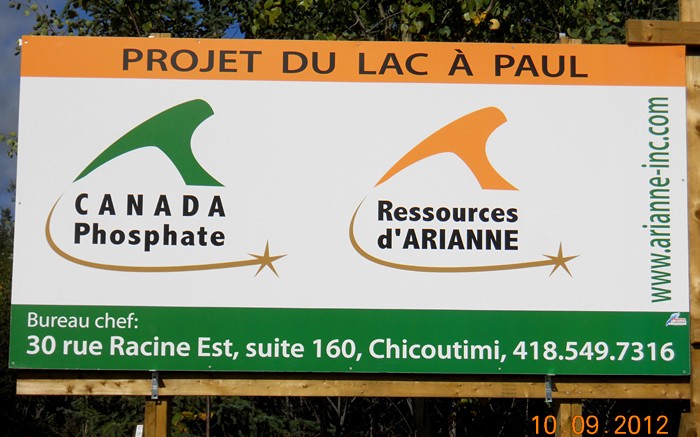Arianne Phosphate’s (TSXV: DAN; US-OTC: DRRSF) Lac à Paul phosphate-rock project in Quebec could be built for US$1.2 billion, a feasibility study shows. Of that amount, US$982.5 million (less US$73.9 million, set aside as contingency), would be spent building the mine and processing plant, and US$232.2 million (less a US$18.1-million contingency), would be spent building the transport system to move the product to the Port of Saguenay.
The feasibility study on what the company likes to describe as “the world’s largest greenfield phosphate-rock project,” 200 km north of the Saguenay–Lac-Saint-Jean region of Quebec, envisions an open-pit mine that would produce 3 million tonnes a year of phosphate concentrate at a grade of 38.6% P2O5 over a 26-year life.
Post-tax numbers were unavailable at press time, but at an 8% discount rate the project is forecast to yield a pre-tax net present value of US$1.9 billion and a 20.7% pre-tax internal rate of return, with payback in four and a half years, before taxes and mining duties.
The feasibility study is based on the project’s Paul zone, which contains measured and indicated resources of 590.24 million tonnes averaging 7.13% P2O5 at a 4% cut-off grade. It does not include the 163.80 million tonnes of measured and indicated material grading 5.88% P2O5 from the Manouane zone, which if added could extend the mine life another eight years, the company estimates.
More upside could come from the Paul zone being open at depth, the company says, and over the last three years Arianne has identified six other mineralized sectors. The new areas — Lise, Lucie, Nicole, Traman, Turc and Traverse — do not have resource estimates.
Based on the feasibility study’s findings, annual operating costs free-on-board the Port of Saguenay per tonne of phosphate concentrate would be US$93.7 per tonne over the mine’s life, which should yield a 56% operating margin. The Lac à Paul average price over the mine life would be US$213 per tonne based on cost data from marketing studies provided by CRU International and Integer Research, the company says.
At full production, the milling rate would be 55,000 tonnes per day, with an average 18.6 million tonnes per year of run-of-mine ore supplied to the process plant. Tailings would be stored 2 km from the concentrator.
Power would come from Hydro-Québec through Rio Tinto’s (NYSE: RIO) power system from the Chute-des-Passes power plant, 30 km from the mine site.
Arianne filed its environmental-impact assessment in June.
Feasibility study results were released after markets closed on Oct. 24. The next day, Arianne’s shares closed 15% higher at $1.44 per share, and rose another 9% to $1.57 per share on Oct. 28.
At press time Arianne’s shares were trading at $1.57, within a 52-week range of 84¢ and $1.69.


Be the first to comment on "CEO: Feasibility shows Arianne’s Lac Paul is a ‘world-class asset’"